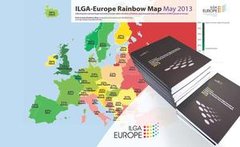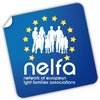ILGA marks IDAHO with publication of the most comprehensive overview of the LGBTI people rights and lives in Europe 2013
16 May 2013
 ILGA Map 2013
ILGA Map 2013Not “la vie en rose”:
the most comprehensive overview of the LGBTI people rights and lives in Europe 2013
To mark the International Day against Homophobia and Transphobia (17 May), ILGA-Europe launches its Rainbow Europe package reviewing the human rights situation and assessing what life is like for lesbian, gay, bisexual, trans and intersex (LGBTI) people in Europe in 2013.
At the national level, we see that developments are at times taking completely opposite directions. Some countries are moving towards marriage equality, better protection mechanisms against discrimination and violence, ensuring easier and more humane procedures for legal gender recognition. However these advances are often accompanied by a social backlash, including increased violence. In other countries, the most worrying development is the introduction of more restrictive and discriminatory measures such as the laws banning ’homosexual propaganda’.
Martin K.I. Christensen, Co-Chair of ILGA-Europe’s Executive Board, said:
“Our Rainbow Europe package clearly shows that full respect of LGBTI people’s human rights remains a long-term aspiration rather than a goal which will be reached in a near future. Not a single country in Europe fulfils 100% requirements of our Rainbow Map. In many countries, the fight is still for fundamental civil and political rights that most of us living in democratic societies take for granted. And it is particularly worrying that some of these countries are in the EU.”
Gabi Calleja, Co-Chair of ILGA-Europe’s Executive Board, continued:
“The Annual Review 2013 uncovers the real situation of LGBTI people beyond laws and gives us the whole picture of what it is like to be an LGBTI person in Europe today. The picture is far from satisfactory. While some countries are scoring high on the Rainbow Map because they have good laws, the situation on the ground often is very different. Even in countries with the most advanced laws and policies, there is a surprisingly high percentage of LGBTI people who are adjusting their behaviours on a daily basis because they fear violence and harassment when in public.”
The results of the EU’s Fundamental Rights Agency survey of 93,000 LGBT people to be released on 17 May, support our finding – 25% of respondents have experienced violence for the last 5 years. The results suggest that discrimination is still unfortunately a life time companion of LGBT people.”
When it comes to European institutions, the Council of Europe is where most progress was seen, as a system of monitoring the human rights situation of LGBTI people is emerging within the institution. Sadly, no major specific legislative or policy changes aimed at advancing equality for LGBTI people were adopted at the European Union level. EU Member States continued to block the adoption of the comprehensive Anti-Discrimination Directive and the EU Commission did not signal its intention to introduce an EU policy framework on LGBTI issues, despite numerous calls from the European Parliament and civil society.
Nils Muižnieks, Council of Europe Commissioner for Human Rights, commenting on our Rainbow Europe package, said:
“Advocacy based on solid facts is what we need for advancing the human rights of LGBTI people. ILGA-Europe and its national member organisations have first-hand knowledge of what is going on and share their insights and concerns through the Annual Review and the Rainbow Map. In addition to holding countries accountable for their actions, the Annual Review also gives a critical account of the steps taken by international organisations. It is a valuable tool for a serious debate about the human rights situation of LGBTI persons across Europe.”
The Rainbow Europe package consists of two major documents:
- Rainbow Europe Map reflecting the 49 European countries’ legislation and policies that have a direct impact on the enjoyment of human rights by LGBTI people. The Rainbow Map reflects each country’s situation and provides overall score on how far this country is on a scale between 0% and 100%.
- Second edition of ILGA-Europe Annual Review of the Human Rights Situation of LGBTI People in Europe provides insights into the political and social developments and thus complements the more legally oriented Rainbow Europe Map with a feeling of what an everyday life and environment for LGBTI people is in different European countries.
Ends
For more information please contact
Juris Lavrikovs at + 32 2 609 54 16 / + 32 496 708 375
Notes for editors:
(1) ILGA-Europe is the European Region of ILGA, the International Lesbian, Gay, Bisexual, Trans and Intersex Association and works for human rights of lesbian, gay, bisexual, trans & intersex people in Europe. ILGA-Europe represents 400 member organisations in 45 European countries: www.ilga-europe.org
(2) You can download Annual Review of the Human Rights Situation of LGBTI People in Europe 2013, Rainbow Europe Map 2013 as well as score sheets on each individual European country based on the Rainbow Map 2013 on our website: www.ilga-europe.org/rainboweurope
Score sheets for all European countries in their official languages will be downloadable from our website from tomorrow 12:00 at the same link.



 Marriage Equality is a proud member of NELFA
Marriage Equality is a proud member of NELFA